|
1.
|
Social Security Expenditure in fiscal year
2002 was 83,566.7 billion yen.
|
|
 |
 |
 |
| ( i ) |
|
Of the three categories,
Medical care was estimated at 26,274.4 billion yen,
accounting for 31.4 percent of the total; Pensions
was 44,378.1 billion yen for a total share of 53.1 percent.
Welfare & Others was 12,914.0 billion yen for a total
share of 15.5 percent. |
| ( ii ) |
|
Social Security Expenditure
increased by 2.7 percent in fiscal year 2002. The percentage
share of the National Income was 23.03 percent. |
| ( iii ) |
|
Social Security Expenditure
per head of population was estimated at 655,800 yen, and
the average expenditure per household was 1,795,500 yen. |
Table 1 Social Security Expenditure
by category, fiscal years 2001 and 2002
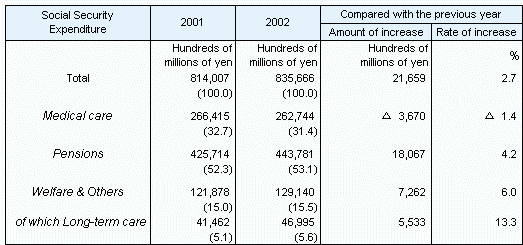
Note: ( ) The ratio to the total is expressed as a percentage.
Table 2 Social Security Expenditure
by category as a percentage of National Income
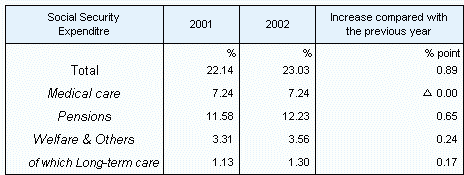
Table 3 Social Security Expenditure
per head of population and per household, fiscal years 2001
and 2002

|
Notes:
|
Social Security Expenditure per household
= (Number of people in the household/Total number of
households) × Social Security Expenditure per head
of population.
|
Figure 1 Social Security Expenditure
by category, fiscal years 1970-2002

|
|
2.
|
As can be seen in Table 4 below showing Social
Security Expenditure by functional category, “Old age”
heads the list with 49.3% of the total, followed by "Sickness
and health" at 30.9%. These two functional categories make up
approximately 80.0% of the entire Social Security Expenditure.
The other functional categories and their percentages of the
total are “Survivors” (7.3%), “Unemployment”
(3.0%), “Family benefits” (3.2%), “Invalidity
benefits” (2.3%), “Social assistance and others”
(2.4%), “Employment injury” (1.2%) and “Housing”
(0.3%).
|
Table 4 Social Security Expenditure by functional
category, fiscal years 2001 and 2002
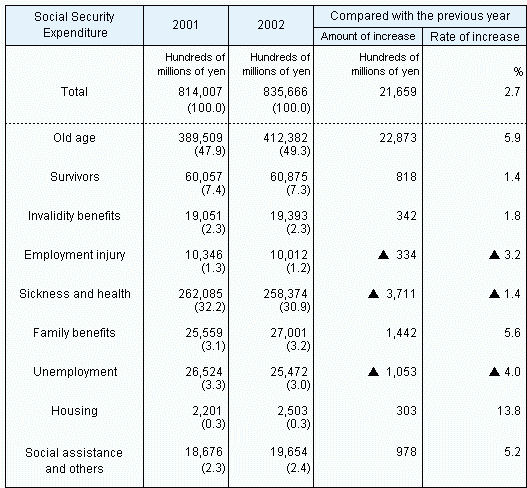
|
Notes:
|
1. ( ) The ratio to the total is expressed
as a percentage.
|
|
|
2. Refer to ‘Reference’
for more details about functional classifications. |
Table 5 Social Security Expenditure by functional
category as a percentage of National Income
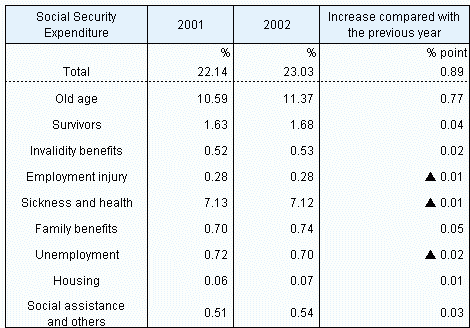
Figure 2 Social Security Expenditure by
functional category, fiscal years 1998-2002
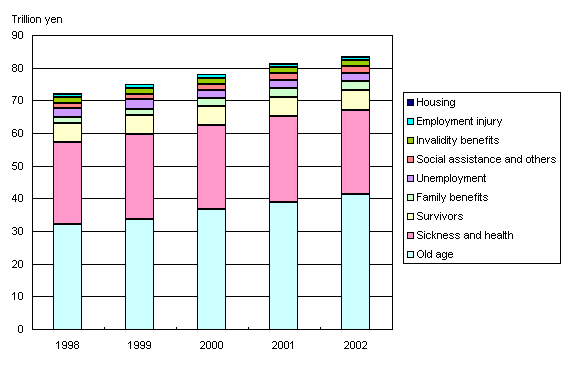
|
3.
|
Social Security Expenditure for the elderly
(i.e., retirement pensions, medical care for the aged, welfare
services for the aged) was 58,437.9 billion yen. Its share of
Social Security Expenditure was 69.9 percent.
|
Table 6 Social Security Expenditure for
the elderly, fiscal years 2001 and 2002
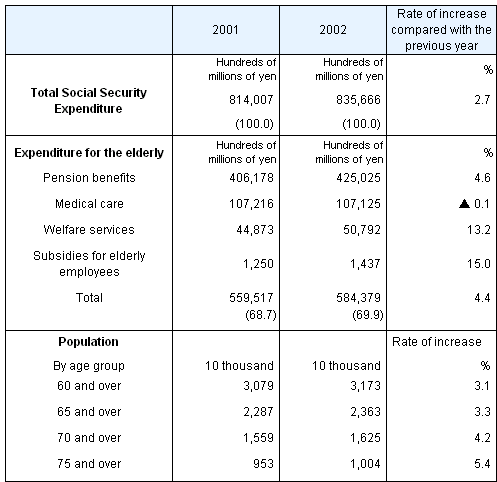
|
Notes:
|
1.
|
The ratio to the total Social Security Expenditure
is expressed as a percentage.
|
|
|
2.
|
Health and medical services expenditure for
the aged consists of expenditures concerning measures for care
control, the in-home welfare service expense not covered by
long-term care insurance, etc.
|
| |
3.
|
Subsidies for elderly employees are grants
in which, from the viewpoint of promoting continued employment
and re-employment for 60 to 65-year-olds, 25 percent of the
wages earned by people over 60 years of age are provided to
those elderly people continuing to work and whose wages have
dropped considerably since turning 60. This grant is provided
to elderly people under the age of 65.
|
Return to the Contents
Return to the top page of The Cost of Social Security in Japan

|